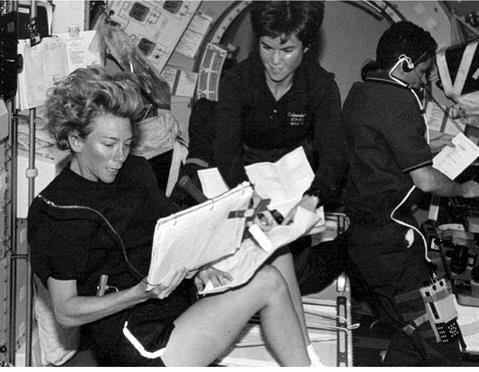STS-94
 1997-032A 1 July 1997
1997-032A 1 July 1997
Pad 39A, Kennedy Space Center, Florida 17 July 1997
Runway 33, Shuttle Landing Facility, KSC, Florida OV-102 Columbia/ET-86/SRB BI-088/SSME #1 2037; #2 2034; #3 2033 15 days 16hrs 34 min 4 sec
Columbia Objective Material Science Laboratory 1 (Re-flight)
Flight Crew
HALSELL Jr., James Donald, 40, USAF, commander, 4th mission Previous missions: STS-65 (1994); STS-74 (1995); STS-83 (1997)
STILL, Susan Leigh, 35, USN, pilot, 2nd mission Previous mission: STS-83 (1997)
VOSS, Janice Elaine, 40, civilian, mission specialist 1, payload commander,
4th mission
Previous missions: STS-57 (1993); STS-63 (1995); STS-83 (1997) GERNHARDT, Michael Landen, 40, civilian, mission specialist 2, 3rd mission Previous missions: STS-69 (1995); STS-83 (1997)
THOMAS, Donald Alan, 41, civilian, mission specialist 3, 4th mission Previous missions: STS-65 (1994); STS-70 (1995); STS-83 (1997)
CROUCH, Roger Keith, 57, civilian, payload specialist 1, 2nd mission Previous mission: STS-83 (1997)
LINTERIS, Gregory Thomas, 39, civilian, payload specialist 2, 2nd mission Previous mission: STS-83 (1997)
Flight Log
The 84-day turnaround from the landing of STS-83 to the launch of the re-flight mission, designated STS-94, was a new record and an impressive demonstration of the ability and skills of the processing team. The quick turnaround was in part facilitated by servicing the MSL payloads while still in the payload bay of Columbia. The original STS-94 mission was manifested as a “flight opportunity” by Discovery in October 1998, but as no payload had been assigned to that flight, it was the first available flight number to assign the MSL administration and planning documents to. As the same vehicle, crew and payload would be flying, it was in effect a “paper change” to the flight designation, although a new ET, SRBs and different SSMEs were
|
Susan Still (left) and Janice Voss review In-flight Maintenance (IFM) procedures during one of the daily planning sessions in the Spacelab Science Module in support of the MSL mission. Meanwhile Greg Linteris works at a laptop computer in the background |
assigned to support the new mission. There was a delay to the launch due to unacceptable weather around the SLF.
With the crew operating the familiar Red and Blue two-shift system, 33 investigations were completed in the fields of combustion, biotechnology and materials processing. There were 25 primary investigations, four glove box investigations and four accelerometer studies on MSL-1. Some of this work involved evaluating hardware, facilities and procedures in preparation for similar hardware and research programmes that were due to be carried out on ISS. Within the combustion investigations, 144 experiments were planned, and over 200 were actually completed. The TEMPUS electromagnetic containerless processing facility completed over 120 melting cycles of zirconium at temperatures ranging between 340 and 2,000° C. In the “ignition of large fuel droplets” experiment, conducted in the glove box, only 52 test runs were planned, but the crew managed to complete 125 by the end of the mission. There were in excess of 700 crystals of various proteins grown during the 16-day mission and a record number of commands (over 35,000) were sent from the Spacelab Mission Operations Control Center at Marshall Space Flight Center to the MSL-1 experiments.
On 2 July, Don Thomas reported sighting the Mir space station as it passed within 100 km of Columbia. Two days later, as America celebrated Independence Day, the crew sent messages of congratulations to the JPL Pathfinder team in California on the successful landing of the Mars Pathfinder spacecraft on the Red Planet. Three days later, the crew were informed of the successful docking of a Russian Progress (M35) re-supply vehicle with Mir and the following day, Halsell, Gernhardt and Voss used the SAREX equipment aboard Columbia to talk with Mike Foale aboard the Mir space station. On 14 July, the crew reported a minute debris impact with one of the overhead windows, a familiar occurrence which again was no cause for concern over safety. Shuttle windows are often hit by small pieces of space debris during orbital flight. Being multi-layer panels, such small impacts are highly unlikely to jeopardise the integrity of the window or the safety of the crew and vehicle.
Milestones
199th manned space flight 115th US manned space flight 85th Shuttle mission 23rd flight of Columbia
1st re-flight of same vehicle, payload and crew 15th flight of Spacelab Long Module 11th EDO mission











